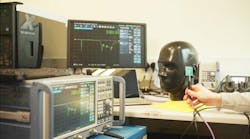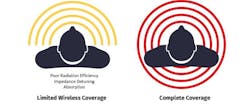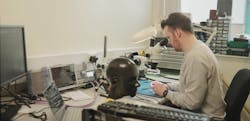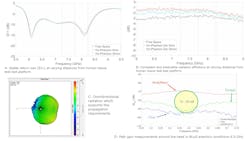Optimizing Antenna Selection for Near-Human-Body Systems
Members can download this article in PDF format.
What you’ll learn:
- How wireless systems operate close to the human body.
- Antenna selection issues.
- Factors to consider when choosing an antenna.
In the world of electromagnetics, we can’t do wireless without antennas, which work brilliantly when mounted away from objects and suspended in free space. Their efficiency is generally only limited to copper and substrate losses, with radiation efficiencies of 90%+ possible. It’s when they’re integrated into something and placed near other objects that performance becomes more uncertain.
To achieve efficient and optimal wireless performance on difficult platforms, the antenna should be one of the first things considered in a design, and not treated as an afterthought. With an understanding of the propagation channel requirements and an antenna that supports these requirements, superior performance reliability and quality can be achieved.
Challenges with Wireless Systems and the Human Body
The human body is often seen as one of the most difficult platforms for the deployment of wireless systems, due to the variability of the properties across different positions on the body, and across the different morphologies of the human population. Conductive platforms make wireless communication difficult when the device is mounted close to the structure. Just like metal, the human body appears electrically conductive to electromagnetic waves, and appears more conductive as frequency is increased.
Much can be learned from devices designed to operate near the human body, as it’s a lossy and dynamic platform that obstructs and drastically limits wireless coverage in the microwave frequency range from 300 MHz (Fig. 1). Improvements in the physical-layer performance are advantageous for more robust and reliable connectivity, longer communication ranges, lower transmit powers, or simply more confidence in design before product deployment.
A combined antennas and propagation approach is explored here to improve the physical layer performance of wireless body-centric networks. The techniques and understanding from the experimental measurements can be used to solve wireless connectivity problems on broader platforms such as close to metal for other communication applications.
The All-Important Antenna
The physical layer of the wireless system, namely the antenna, is the part of the system that interacts with the environment it’s placed in. Placing the antenna close to different materials will impact the performance of the antenna. In particular, it can change the impedance of the antenna and its radiation characteristics.
Antennas that are sensitive to being placed next to conductive materials, such as printed antennas, or chip antennas with bespoke PCB keep-out areas, often exhibit the greatest performance variation. Nonetheless, the wireless performance of the system then depends greatly on the host platform.
For some applications, where the platform is known and the materials are well defined, the antenna can be optimized specifically for that platform. However, for applications such as the distribution of wireless sensors, where they’re expected to consistently perform wherever they may be deployed, needs a different approach to achieve optimal and reliable communication links.
The human body presents a unique challenge for wireless technology, with its variable complexities. That means the wireless performance for devices in close proximity to tissue are difficult to characterize and ensure robust and reliable operation on every person, in every application use case.
In wearable products today, many systems use printed PCB antennas or opt for small chip antennas with size being the primary selection factor, rather than wireless performance. These antennas usually come with strict guidance on the PCB layout and shaped keep-out areas to ensure the antenna radiates. In most cases, it’s not the antenna supporting the radiation but the surrounding ground-plane edge and the antenna feed line.
If the designer deviates from the spec sheet keep-out area guidance, the performance suffers significantly. Often, selection aligns with what the SoC development kit used, so it must be “OK.” Yes, it is, for something sitting on a desk that needs to communicate a few meters, but not the right approach for product deployment. The question remains: “How would it perform on every person or any platform?”
Standard Antenna Selection: What to Consider
A number of metrics are important when considering an antenna's performance. However, for difficult or unknown platforms, the top three are input impedance stability, total radiation efficiency, and the correct radiation pattern to meet the propagation needs of the application.
To evaluate end-to-end communication link performance, Received Signal Strength Indicator (RSSI) or forward path gain (|S21|) are important metrics to quantify the propagation mode effectiveness. The wireless performance is only as good as its weakest link.
It’s advisable to test for worst-case body-blocking scenarios with non-line-of-sight (NLoS) propagation and no significant nearby objects for the electromagnetic waves to reflect and diffract off (low multipath environments). In this type of environment, the received signal strength will be weakest, and performance is marginal at distance.
A communication system that performs effectively in NLoS anechoic environments doesn’t depend on the proximity of nearby objects for multipath communication. Thus, it has more reliable performance as the platform moves through or is deployed in different environments.
Therefore, to get the best quality of performance from a wearable wireless device, it must strive to exhibit the following characteristics on different people and at different antenna-body spacing distances on the same person/platform:
- Stable return loss |S11| or resonant frequency
- Minimal power absorption into the tissue
- Predictable or repeatable radiation efficiency reduction
- Overcome body shadowing (limited wireless coverage)
And, finally, it must be tested and validated for worst-case scenarios, i.e., when the wireless received signal is weakest and the communication link becomes marginal or drops out (Fig. 2).
NLoS Performance Enhancement
When all of the above is understood, and the right antennas are used, gains of 10 to 20 dB in worst-case NLoS are achievable versus conventional printed antennas and chip antenna approaches. The performance enhancement and gains can be validated in the forward path gain, measured between the transmitting and receiving wearable antennas.
AntennaWare developed an antenna technology called BodyWave that’s designed specifically for proximity to difficult platforms, with results shown in Figure 3. The results reveal what good looks like. And with combined antenna characteristic performance gains, achieving up to 20 dB, it overcomes body-blocking in NLoS conditions.
In Figure 3d, the path gain of the antennas |S21| was measured from ear to ear for the BodyWave antenna and compared to chip and printed monopole UWB antennas. Even for a short link around the head, the path loss could be as great at 95 dB when using printed and chip antennas as the antenna under test.
Don’t Treat Antennas as an Afterthought
An antenna that’s agnostic to the platform holds the key to unlocking the wireless performance and differentiating product performance. To mitigate the effects of near-field coupling from the antenna to the tissue, and the absorption of energy into the tissue, the antenna must be decoupled from the platform.
PCB printed antennas and ceramic chip antennas are not the right approach. They were never designed to be placed close to a difficult platform, thus radiating inefficiently, and are subject to varying impedance caused by near-field coupling.
Launching the electromagnetic waves to support on-body propagation, in addition to isolating the antenna from the tissue by placing it above the PCB ground plane, has led to significant performance gains of up to 20 dB. To achieve optimal performance from the wireless link on difficult platforms, and maximize available link budget, it’s recommended to start with the antenna radiation characteristics and selection, rather than treating antennas as an afterthought.
The step-change improvement in link budget performance by overcoming body blocking could more than double the communication distance, significantly reducing the power and battery size. Or it could simply provide a more robust and reliable quality connectivity, which is core to wearable audio, sport, and healthcare applications.
Read more articles in the TechXchange: Antenna Design.
References
Conway. G.A., Magill, M.K., Quinn, B.G., “Understanding and Solving the Wireless Connectivity Problem on Difficult Platforms, A Physical Layer Antennas & Propagation Approach” Embedded World Exhibition & Conference, Nuremburg, Germany April 2024.
Conway, G.A., Cotton, S.L., & Scanlon, W.G. (2009). “An Antennas and Propagation Approach to Improving Physical Layer Performance in Wireless Body Area Networks,” IEEE Journal on Selected Areas in Communications, 27(1), 27-36. Article 4740883. https://doi.org/10.1109/JSAC.2009.090104
Conway. G.A., Magill, M.K., “Unlocking Wireless Performance on Difficult Platforms,” October 2023.




